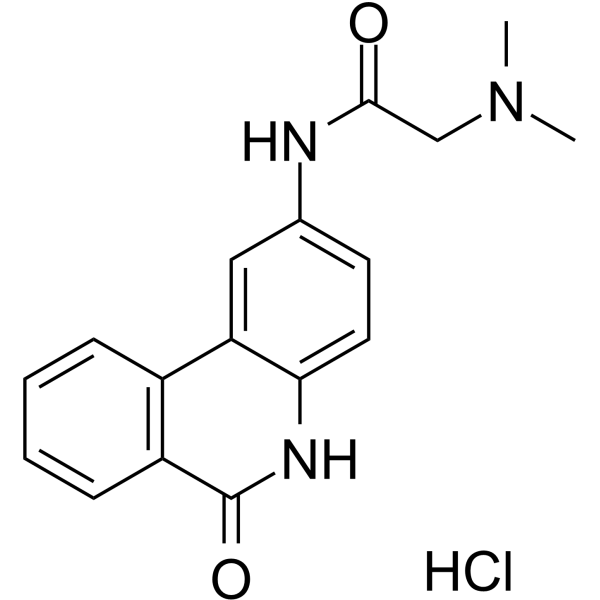Home
Products
PJ34 HCl



| Product Name | PJ34 HCl |
| Price: | Inquiry |
| Catalog No.: | CN00239 |
| CAS No.: | 344458-15-7 |
| Molecular Formula: | C17H17N3O2.HCl |
| Molecular Weight: | 331.8 g/mol |
| Purity: | >=98% |
| Type of Compound: | Alkaloids |
| Physical Desc.: | Powder |
| Source: | |
| Solvent: | Chloroform, Dichloromethane, Ethyl Acetate, DMSO, Acetone, etc. |
| SMILES: | CN(CC(=O)Nc1ccc2c(c1)c1ccccc1c(=O)[nH]2)C.Cl |
| Contact us | |
|---|---|
| First Name: | |
| Last Name: | |
| E-mail: | |
| Question: | |
| Description | PJ34 hydrochloride is an inhibitor of PARPl1/2 with IC50 of 110 nM and 86 nM, respectively. |
| Target | PARP-2:86 nM (IC50) PARP-1:110 nM (IC50) PARP:110 nM (IC50) |
| In Vitro | PJ34 inhibits the PARP enzyme activity with an IC50 of 110±1.9 nM. To compare the neuroprotective properties of other PARP inhibitors in PC12 cells, PJ34 is evaluated using by LDH assay. PJ34 treatment also significantly and concentration dependently attenuates cell death at a concentration ranging from 10-7 to 10-5 M[1]. |
| In Vivo | To compare the potency and efficacy with other PARP inhibitors, PJ34 is evaluated at the doses of 3.2 and 10 mg/kg, respectively. PJ34 at the dose of 3.2 mg/kg significantly reduces cortical damage by 33%; however, 10 mg/kg dosing shows reversed effect (17% reduction)[1]. PJ34 (25 mg/kg) reduces the levels of TNF-α mRNA in ischemic animals by 70% and these values in treated mice do not differ from that of sham or naive animals. Treatment of ischemic mice with PJ34 reduces the level of E-selectin mRNA by 81% and that of ICAM-1 mRNA by 54%, compared to vehicle-treated ischemic mice[2]. |
| Cell Assay | PC12 cell cultured are grown in Dulbecco's modified Eagle's medium supplemented with 5% (v/v) fetal calf serum, 5% (v/v) horse serum, and a 1% (v/v) penicillin-streptomycin antibiotics mixture. Cells are grown in an atmosphere of 95% air and 5% CO2 at 37°C. For all experiment, cells are seeded at a density of 4×104 cells/well in 96-well culture plates and allowed to attach overnight. For assessment of cell viability, hydrogen peroxide-induced cytotoxicity is quantified by a standard measurement of LDH release with the use of the LDH assay kit. Briefly, 6 h after hydrogen peroxide exposure, 20 μL of medium of each well is collected, and the solution prepared from LDH assay kit is added. After incubation at room temperature for 30 min, the reaction is stopped by addition of 1 N HCl, and absorbance is measured at 450 nm using a microplate reader. |
| Animal Admin | Rats[1] For transient focal ischemia, 9- to 10-week-old male Wistar rats (weighing 274-380 g) are used. FR247304, PJ34, or 3-AB, which is suspended with 0.5% methylcellulose, is administered at doses of 10 and 32 mg/kg for FR247304, 3.2 and 10 mg/kg for PJ34, or 32 and 100 mg/kg for 3-AB intraperitonially twice at 10 min before MCA occlusion and 10 min before recirculation. The administration volume is adjusted to 2 mL/kg. Mice[2] Male Swiss albino mice (27-32 g) are used. The PARP inhibitor, PJ34 (1.25, 12.5 or 25 mg/kg) is dissolved in isotonic saline (NaCl, 0.9%) and injected intraperitoneally, in a volume of 10 mL/kg, 15 min before ischemia and again 4 h after the onset of ischemia. Control ischemic mice and sham animals are given vehicle (saline). Naive animals are also included in the studies. |
| Boiling Point | 539.1ºC at 760 mmHg |
| Flash Point | 279.9ºC |
| PSA | 53.17000 |
| LogP | 3.11400 |
| Storage condition | Desiccate at RT |